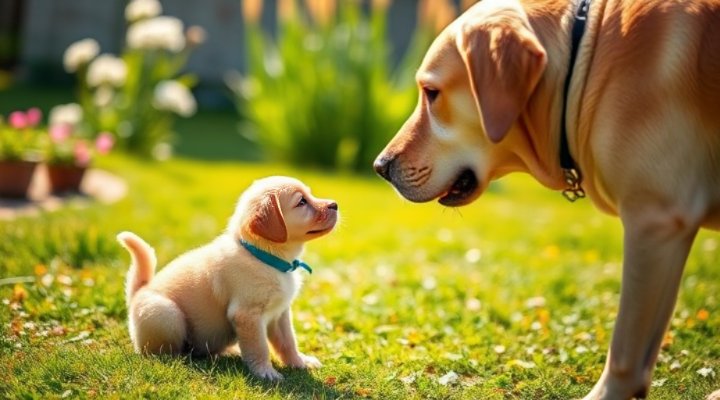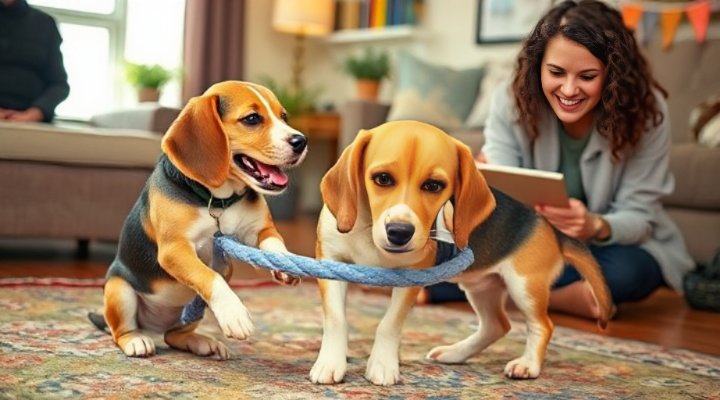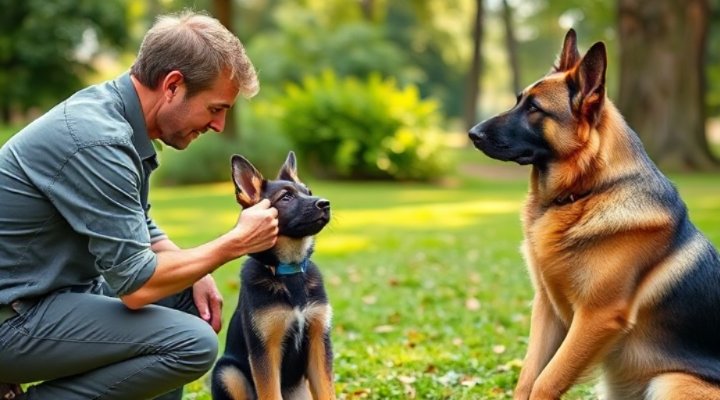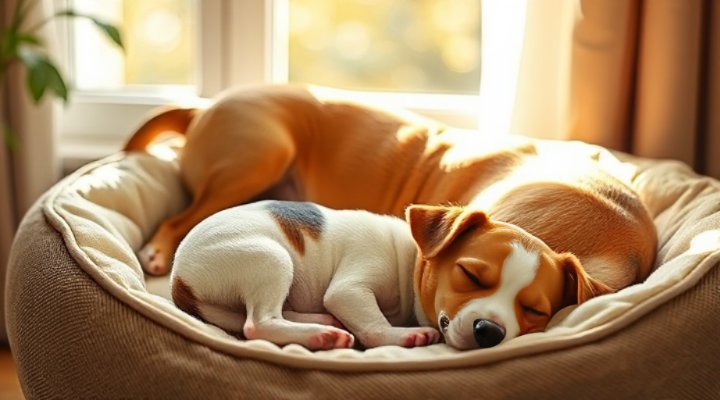Introducing a new puppy to your household when you already have an adult dog requires careful planning and patience. The key to success lies in understanding canine behavior and creating positive associations from the very beginning. Remember, every dog is unique, and what works for one pair might need adjustment for another.

Preparing for the First Introduction
First impressions matter tremendously when bringing a puppy and adult dog together. Choose a neutral territory for their initial meeting – perhaps a quiet park or a friend’s yard. Keep both dogs on leashes but allow enough slack for natural movement. Watch for relaxed body language: loose wagging tails, soft eyes, and curious sniffing are all good signs.
I’ll never forget when I introduced my then 8-week-old Labrador to my 5-year-old Golden Retriever. We did the introduction at a local park early in the morning when it was quiet. The adult dog was definitely curious but maintained a calm demeanor, while the puppy was all wiggles and excitement. After about 15 minutes of supervised sniffing and some parallel walking, we felt comfortable moving to the next phase.
Reading Canine Body Language
Understanding dog body language is crucial during these early interactions. Look for signs of stress in your adult dog like lip licking, yawning, or turning away. These are subtle signals that they might need a break. Puppies, on the other hand, often don’t understand boundaries yet, so you’ll need to intervene if play becomes too intense.

Creating a Peaceful Home Environment
Once the initial introduction goes well, it’s time to think about your home setup. Dogs are territorial by nature, so your adult dog might need time to adjust to sharing their space. Create separate areas for each dog with their own beds, toys, and feeding stations. This prevents resource guarding and gives each dog their own safe space.
Consider using baby gates to create separate zones when you can’t directly supervise. This is especially important during meal times and when you’re not home. The best crate for puppy can also serve as a safe retreat when your adult dog needs a break from the puppy’s boundless energy.
Establishing Routine and Structure
Dogs thrive on routine, and maintaining your adult dog’s schedule helps minimize stress. Feed them at their usual times, maintain their walk schedule, and continue any training rituals. The puppy will adapt to the existing routine rather than disrupting it entirely. According to the American Veterinary Society of Animal Behavior, maintaining predictability reduces anxiety in dogs during transitions.

Training for Harmony
Training both dogs – yes, even your well-behaved adult dog – creates common ground and strengthens your bond with each. Work on basic obedience commands like ‘sit’, ‘stay’, and ‘leave it’ with both dogs separately at first, then gradually introduce joint training sessions.
Positive reinforcement works wonders in these situations. When your adult dog shows patience with the puppy, reward that behavior immediately. Similarly, when the puppy respects the adult dog’s boundaries, celebrate that moment. The obedience training for puppy guide offers excellent techniques for establishing good manners early.
Managing Play Interactions
Play between puppies and adult dogs can look rough to human eyes, but it’s often perfectly normal canine behavior. However, you should intervene if:
- The adult dog shows clear signs of stress
- The puppy isn’t respecting ‘back off’ signals
- Play escalates to true aggression

Addressing Common Challenges
Even with perfect preparation, you might encounter some bumps along the road. Resource guarding, attention-seeking behaviors, and mismatched energy levels are common issues when integrating puppies with adult dogs.
For food or toy guarding, feed dogs separately and supervise toy play. Rotate high-value toys rather than leaving them all out at once. If your adult dog seems jealous of the attention the puppy gets, make sure to carve out special one-on-one time with your older dog. The dog behaviorists near me resource can help if you’re facing persistent issues.
When to Seek Professional Help
While most puppy-adult dog relationships work out with time and patience, some situations require professional intervention. Consult a certified dog behaviorist if you observe:
- Persistent aggressive behavior from either dog
- Extreme fear or anxiety that doesn’t improve
- Inability to eat or rest normally due to stress
The Texas A&M Veterinary Medicine program offers excellent resources on recognizing serious behavioral issues.

Celebrating Success
As weeks pass, you’ll start to see beautiful moments of connection between your puppy and adult dog. Maybe they’ll begin sleeping near each other, or your older dog will start ‘teaching’ the puppy proper canine etiquette. These milestones are worth celebrating!
In my own experience, the turning point came about three months in when I found my adult dog gently cleaning the puppy’s face after a messy meal. That maternal instinct kicking in told me they had truly bonded. Now, two years later, they’re inseparable companions who keep each other active and engaged.
Remember, building a harmonious relationship between a puppy and an adult dog takes time, patience, and consistency. But the reward – a peaceful, loving multi-dog household – is absolutely worth the effort.
Related Keywords: puppy and adult dog introduction, dog behavior modification, positive reinforcement training, multi-dog household, canine body language, resource guarding prevention, dog training techniques
